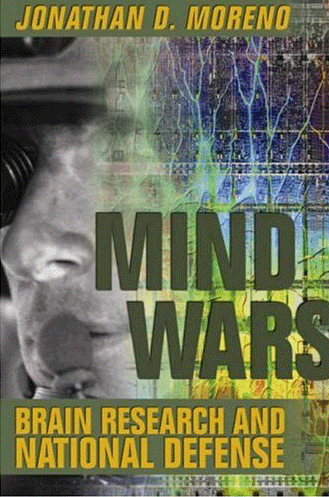 ★
★
嘘の配線図:ジョナサン・モレノ『操作される脳』19
「神経活動を利用して嘘を発見することを目標として、大量の研究が行われているが、少なくとも一つの製品が市販されている。ペンシルヴェニ ア大学の精神医学者ダニエル・ラングリーベンは、嘘をつくことに関連する脳の領域を同定するためにfMRI を使っている。ラングリーベンのチームは、「嘘と真実との認識的な違いにはそれぞれ対応する神経活動があって、それはfMRI で検出できる」と結論づけた。「特に[嘘と]関連して、……前帯状回(anterior cingulate cortex / ACC)、上前頭回(superior frontal gyrus / SFG)、左脳の運動前野、左脳の運動野、左脳の前頭頂葉(anterior parietal cortex [sic])の活動が高まる」のだという。幸いなことだ。私たちは真実を語るように配線されているというわけか。fMRIを用いた嘘発見研究のレビューに よれば、騙そうとする試みは、遂行機能中枢、特に前頭葉と前帯状回の活動と関係しているという。だが、真実を述べるときには特に活性化する領域はないそう だ。シェフィールド大学の神経科学グループは「ということは、真実を述べるのが、人間の認識とコミュニケーションのベースラインになっているのかもしれな い」と述べている。/このテクニックは、今のところ、特定の人物がいつ意図的に嘘をつくかを予測できるほどの効力をもつには至っていない。しかし、私たち にはもともと正直であろうとする傾向があるために、嘘をつくときには脳ががんばらなくてはならないという事実をもとにして、fMRI を嘘発見用に改良するのは可能だと指摘する人もいる。ハーバード大学のジョージオ・ガニスとスティーヴン・コスリンは、巧みに仕組んだ嘘をつこうとすると 脳の多くの領域で活性化が起こることを発した(もっともらしい嘘をつこうと思えば集中しなくてはならないのだ)。また、前もって練習した嘘とその場でつく 嘘を識別することもできた。同様に、南カフォルニア医科大学のチームは、若い男性が嘘をつくときに前帯状固と眼窩前頭野の活動性が高まることを発見した。 科学捜査や国家安全保障にとって、信の高い嘘発見用脳スキャンには潜在的な重要性があるのは明らかだ」(モレノ 2008:203-204)。
| "A slew of studies
and at least one commercial product are aimed at using neural activity
in lie detection. Penn psychiatrist Daniel Langleben is using fMRI to
identify brain regions associated with lying. He and his team have
concluded that "cognitive differences between deception and truth have
neural correlates detectable by fMRI ;' with increased activity in the
"anterior cingulate cortex (ACC), the superior frontal gyrus (SFG), and
the left premotor, motor, and anterior parietal cortex [sic] ...
specifically associated with [deception]:' Happily, it's beginning to
look as if we are wired to tell the truth. A review of studies on the
use of fMRI to detect lying reports that attempts to deceive are
associated with activation of executive function centers, especially
the prefrontal and anterior cingulate cortices, but truthful responses
don't activate any particular areas more than others. "Hence;' a
University of Sheffield neuroscience group concludes, "truthful
responding may comprise a relative 'baseline' in human cognition and
communication:' Techniques aren't yet specific enough to predict when a
particular person is being intentionally deceptive. However, there are
some indications that refinement of fMRI for lie detection is possible,
based on the fact that our natural inclination to be truth fullorces
the brain to work harder when we lie. Harvard's Giorgio Ganis and
Stephen Kosslyn have found that well organized lies involve activation
of many parts of the brain-a convincing ‾e requires concentration-and
rehearsed lies can be distinguished from spontaneous ones. Similarly, a
Medical University of South Carolina team found increased activity
among lying young males in the anterior cingulate and the orbitofrontal
cortex. The forensic and national security implications of a reliable
individual brain scan for lie detection are obvious"(Moreno
2006:103-104). |
「神経活動を利用して嘘を発見することを目標として、大量の研究が行われているが、少なくとも一つの製品が市販されている。ペンシルヴェニ ア大学の精神医学者ダニエル・ラングリーベンは、嘘をつくことに関連する脳の領域を同定するためにfMRI を使っている。ラングリーベンのチームは、「嘘と真実との認識的な違いにはそれぞれ対応する神経活動があって、それはfMRI で検出できる」と結論づけた。「特に[嘘と]関連して、……前帯状回(anterior cingulate cortex / ACC)、上前頭回(superior frontal gyrus / SFG)、左脳の運動前野、左脳の運動野、左脳の前頭頂葉(anterior parietal cortex [sic])の活動が高まる」のだという。幸いなことだ。私たちは真実を語るように配線されているというわけか。fMRIを用いた嘘発見研究のレビューに よれば、騙そうとする試みは、遂行機能中枢、特に前頭葉と前帯状回の活動と関係しているという。だが、真実を述べるときには特に活性化する領域はないそう だ。シェフィールド大学の神経科学グループは「ということは、真実を述べるのが、人間の認識とコミュニケーションのベースラインになっているのかもしれな い」と述べている。/このテクニックは、今のところ、特定の人物がいつ意図的に嘘をつくかを予測できるほどの効力をもつには至っていない。しかし、私たち にはもともと正直であろうとする傾向があるために、嘘をつくときには脳ががんばらなくてはならないという事実をもとにして、fMRI を嘘発見用に改良するのは可能だと指摘する人もいる。ハーバード大学のジョージオ・ガニスとスティーヴン・コスリンは、巧みに仕組んだ嘘をつこうとすると 脳の多くの領域で活性化が起こることを発した(もっともらしい嘘をつこうと思えば集中しなくてはならないのだ)。また、前もって練習した嘘とその場でつく 嘘を識別することもできた。同様に、南カフォルニア医科大学のチームは、若い男性が嘘をつくときに前帯状固と眼窩前頭野の活動性が高まることを発見した。 科学捜査や国家安全保障にとって、信の高い嘘発見用脳スキャンには潜在的な重要性があるのは明らかだ」(モレノ 2008:203-204)。 |
(→原文つき:fMRI & Lie detection)
リンク
文献
その他の情報
Copyleft, CC, Mitzub'ixi Quq Chi'j, 1996-2099
 ★
★

Do not paste, but [Re]Think our message for all undergraduate students!!!